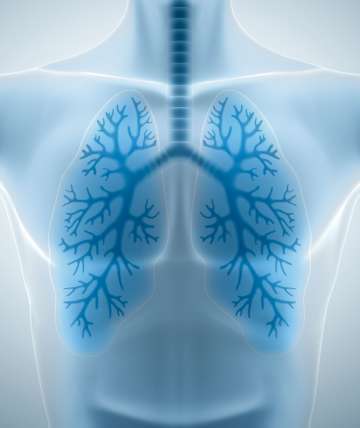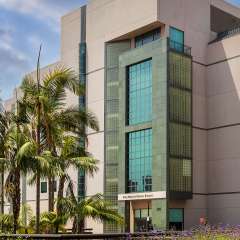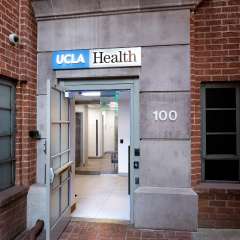Complex Airway Surgery for Adults

Why choose UCLA Health for complex airway surgery?
Complex airway conditions affect breathing and require highly specialized care. The UCLA Health Complex Airway Surgery team is known worldwide for exceptional treatment that improves people’s quality of life. When you choose UCLA Health for complex airway surgery, you can expect:
Recognized excellence: UCLA Health’s head and neck surgery program is consistently ranked among the nation’s best by U.S. News & World Report. Many of our head and neck physicians are included among Los Angeles Magazine’s “Top Doctors” and “Super Doctors” of Southern California.
Advanced expertise: Our providers have decades of experience diagnosing and treating the full spectrum of airway disorders. Our breadth and depth of knowledge leads to successful outcomes.
Team approach: Our complex airway team includes specialists in otolaryngology (ear, nose and throat care), thoracic (chest) surgery, interventional pulmonology (focuses on minimally invasive ways to treat airway conditions), gastroenterology (cares for the digestive system), speech-language pathology and respiratory therapy.
Convenient care: We can perform many diagnostic and treatment procedures in our office instead of the hospital.
Research focus: UCLA Health physician-scientists are at the forefront of clinical and laboratory research in airway conditions. Our faculty regularly publish their research to advance airway care.
Types of complex airway conditions we treat
The airway or respiratory tract includes structures and organs that bring in oxygen and remove carbon dioxide. Breathing and speaking can be difficult when parts of the airway, including the pharynx (throat), larynx (voice box) and trachea (windpipe), are narrow or obstructed. Various airway disorders also affect swallowing.
Some airway conditions may be congenital (present at birth). Others are caused by trauma, disease or prolonged use of a breathing tube.
Our team treats all conditions affecting your airway, including:
Airway stenosis
Airway stenosis is a narrowing of the airway, which causes hoarseness or difficulty breathing. Airway stenosis types depend on their location and include:
- Glottic stenosis: Narrowing of the larynx at the vocal cords
- Subglottic stenosis: Narrowing of the larynx below the vocal cords
- Tracheal stenosis: Narrowing of the trachea
- Post-intubation airway stenosis: Tracheal stenosis resulting from prolonged intubation or tracheostomy (surgical opening in the front of the neck into the windpipe)
- Post-radiation pharyngeal and airway stenosis: Stenosis that happens after radiation treatment
Other complex airway conditions
Many other conditions can affect your ability to breathe, such as:
- Bilateral vocal fold paralysis: The vocal folds don’t move, affecting breathing and speaking.
- Laryngeal tumors: Abnormal cells develop and multiply in the larynx, forming a tumor. Laryngeal tumors can be cancerous (malignant) or noncancerous (benign).
- Recurrent respiratory papillomatosis: The human papillomavirus (HPV) causes benign wart-like growths on or near the vocal cords, resulting in hoarseness or other voice changes. Large growths may also make breathing difficult. The growths return after removal because the virus is still in the tissue.
- Stridor: This is noisy breathing caused by vocal cord paralysis or an obstruction or narrowing in the airway.
- Tracheobronchomalacia: Tissues of the airway become soft and weak, causing a partial airway obstruction.
- Tracheoesophageal fistula: An abnormal connection between the esophagus and trachea allows food and liquids to reach the lungs. This anomaly can be congenital or occur from other conditions.
- Tracheostomy dependence and tracheostomy-related disorders: Some patients need a tracheostomy tube to help with breathing. Prolonged use of a trach tube for ventilation can cause various complications.
Tests and procedures we offer
Your doctor may refer you to an ear, nose and throat (ENT) doctor (otolaryngologist). ENTs have specialized training in airway conditions and can develop a treatment plan to help you feel better.
Diagnosing complex airway conditions
Our providers use several tests to diagnose airway and swallowing problems, including:
Lab tests
We may request samples of blood, urine or tissues to analyze in a lab. Information from lab tests can provide valuable health insights.
Imaging
Your doctor may request detailed pictures of your airways, lungs and blood vessels. Common imaging tests include:
- Chest X-ray: This technique uses electromagnetic radiation to capture images of the inside of your chest.
- Computed tomography (CT) scan: This scan combines X-rays and computers to produce detailed images of airway structures and the chest area.
- Magnetic resonance imaging (MRI): This test uses radio waves, high-powered magnets and a computer to create detailed images of your respiratory system.
- Esophagram (barium swallow study): You swallow a solution with barium, which coats your esophagus as it moves down to the stomach. This solution helps your doctor see your esophagus in action during a specialized X-ray.
- Modified barium swallow study: This test is like a barium swallow but checks to see if food or liquids enter your lungs.
Endoscopic imaging tests
We insert a flexible or rigid tube with a light and camera at the end (endoscope) through the nose or mouth to view portions of the airway. Specialized endoscopic tests we perform in our office include:
- Laryngoscopy: Views the larynx
- Bronchoscopy: Looks at the trachea
- Esophagoscopy: Evaluates the esophagus
- Flexible (fiberoptic) endoscopic evaluation of swallowing: A laryngoscopy that focuses on the swallowing process
- Transnasal esophagoscopy: Views the esophagus by entering through the nose instead of the mouth
- Triple endoscopy: Evaluates the larynx, upper and lower airway, and upper gastrointestinal tract in a single endoscopic procedure in the hospital
- Videostroboscopy: Views the vocal cords as you make sounds
- Endoscopic biopsy: Takes tissue samples to be analyzed in a lab
Treating complex airway conditions
Most airway treatments aim to widen the airway and remove obstructions to make breathing easier. Depending on your specific diagnosis and needs, your airway treatment may include oral medications, injections, surgery or a combination .
Nonsurgical treatments for complex airway conditions
Medications can help treat some airway conditions. Your doctor may also inject steroids into the airway structures to reduce inflammation.
Endoscopic treatments for complex airway conditions
Our doctors use minimally invasive surgical treatments when possible. These include:
- Dilation: This procedure stretches and opens the airway by temporarily inflating and then removing a small balloon.
- Stenting: Your doctor inserts a metal or silicone tube-shaped device to keep the airway open.
- Ablation therapy: Your doctor uses focused heat, cold or lasers to destroy scar tissue or tumors in the airway.
Open surgical procedures to treat complex airway conditions
Some airway treatments require open surgery, which involves a skin incision to access the airway. Our surgeons are highly experienced in all complex airway surgeries, including those for the larynx, trachea and vocal cords:
Larynx
Larynx surgeries we perform include:
- Laryngeal reinnervation: This procedure restores nerve connections in the larynx, helping the vocal cords function.
- Laryngotracheal reconstruction (laryngotracheoplasty): Your doctor removes a small piece of cartilage from elsewhere in your body (a graft). They then insert the graft in the windpipe to widen it and make breathing easier.
- Partial laryngectomy: This surgery removes a portion of the larynx to treat cancerous tumors.
- Transoral laser microsurgery: Your doctor uses powerful lasers at the end of an endoscope to remove laryngeal tumors.
Trachea
We perform many tracheal procedures, such as:
- Cricotracheal resection: Your doctor removes the narrowed portion of the airway below the larynx and reconnects the healthy sections.
- Tracheal resection: Your doctor removes the diseased, scarred or narrowed portion of the trachea and connects the remaining ends.
- Tracheal t-tube: A t-shaped silicone stent holds the airway open for adequate breathing. It’s typically used after tracheal stenosis surgery.
- Tracheoesophageal fistula repair: Your doctor separates the trachea and esophagus and closes the openings in each passageway.
- Tracheostomy: Your doctor makes an incision in your trachea and inserts a tracheostomy tube in your airway to help with breathing. The process to remove a tracheostomy tube is called decannulation.
- Tracheostomy revisions and tracheostomaplasty: Your doctor modifies or reconstructs the tracheal stoma (tracheostomy).
Vocal cords and other airway structures
Surgery for vocal cords and other airway structures may include:
- Phonosurgery: A variety of surgical procedures to treat a vocal cord abnormality can improve voice quality and sound production.
- Vocal fold medialization surgery: This surgery repositions a paralyzed vocal cord so the functioning vocal cord can work properly.
- Epiglottoplasty: This procedure reshapes the epiglottis (the cartilage at the top of your voice box) when it is dysfunctional or obstructive.
- Pharyngoplasty: This surgery reshapes the soft palate in the roof of your mouth and surrounding areas (pharynx), usually to treat nasal-sounding speech.

Head & Neck Surgery

Santa Monica Head & Neck Surgery

Beverly Hills Primary & Specialty Care
Contact us
Call 310-206-6688 to schedule an appointment with an airway specialist at UCLA Health.
Find your care
Our head and neck surgeons consistently rank among the best in their field. To learn more, call 310-206-6688.
